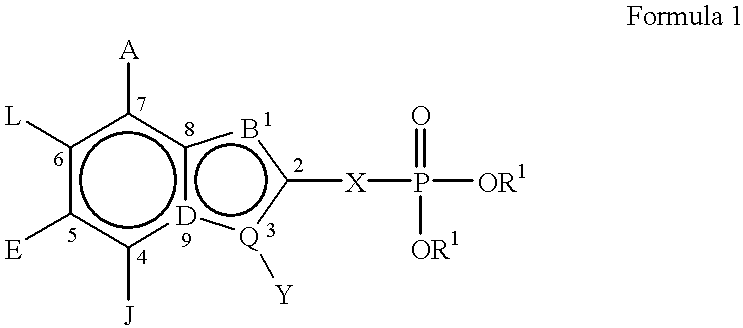Indole and azaindole inhibitors of Fructose-1,6-biphosphatase
a technology of fructose and azaindole, which is applied in the direction of organic chemistry, chemistry apparatus and processes, and group 5/15 element organic compounds, can solve the problems of limiting the overall success of niddm patients, affecting the overall success of niddm, and a large segment of the niddm population that does not respond adequately to sulfonylurea therapy
- Summary
- Abstract
- Description
- Claims
- Application Information
AI Technical Summary
Benefits of technology
Problems solved by technology
Method used
Image
Examples
example 1
Preparation of 2-(phosphonomethylaminocarbonyl)indoles
Step A.
To a solution of 3.0 g (12.8 mmol) ethyl-7-nitroindole-2-carboxylate in 10 mL of methanol was added 10 mL of 1N sodium hydroxide and the reaction mixture was heated at 90.degree. C. for 90 minutes. The solution was acidified with 3N hydrochloric acid and the solid formed was filtered and washed with water. The solid 1.9 g (9.2 mmol, 72.1%) was dried to give a light yellow powder.
Step B.
To a solution of 7.5 g (36.4 mmol) 7-nitroindole-2-carboxylic acid, 20 mL methylene chloride, 6.5 mL diisopropylethyl amine and 5.8 mL (40.0 mmol) diethyl(aminomethyl)phosphonate was added 18.9 g (36.4 mmol) PyBOP. The reaction contents were stirred at room temperature for four hours, filtered and eluted through a pad of silica with ethyl acetate. The filtrate was evaporated under reduced pressure and was resuspended in a minimum amount of ethylacetate. The resulting solid was filtered and dried to give 10.1 g (28.4 mmol, 78%) of a light yel...
example 2
Preparation of 2-phosphonomethylamido-3-phenyl-7-aminoindole
Steps A and B were the same as in Example 1.
Step C.
To a solution of 35 mL of methanol, sodium hydroxide (19.2 mmol) in 2 mL of water, 2-[diethyl(carboxymethyl)phosphonate]-7-nitroindole (11.2 mmol) was added a 5 mL 1 / 1 methanol / water solution of potasium iodide (20.5 mmol ) and iodine (22.8 mmol). The mixture was stirred for 30 min and the volume was reduced under reduced pressure. The resultant solid was filtered, washed with water and acetonitrile to yield 2-diethyl phosphonomethylaminocarbonyl-3-iodo-7-nitroindole (11 mmol, 98%) as a light yellow powder.
Step D.
To a solution of 2-diethyl phosphonomethylaminocarbonyl-3-iodo-7-nitroindole (0.42 mmol) and 3 mL diglyme was added 1 mL saturated sodium carbonate solution, and 26 mg (0.23 mmol) tetrakis(triphenylphosphine) palladium. To this solution was further added a solution of phenylboronic acid (2.3 mmol) in 1 mL ethanol. The reaction was heated to 120.degree. C. and reflu...
example 3
Preparation of 2-phosphonomethylamido-3-phenethyl-7-aminoindole
Steps A and B were the same as in Example 1 and Step C was the same as in Example 2.
Step D.
To a solution of 1.0 g (2.1 mmol) of 2-diethylphosphonomethylamido-3-iodo-7-nitroindole in 70 mL of acetonitrile and 20 mL of triethylamine wasadded 1.0 mL (11 mmol) phenylacetylene, followed by 25 mg (0.13 mmol) of Cul and 20 mg (0.028 mmol) of bis(triphenylphosphine)dichloropalladium. The reaction was heated to 60.degree. C. for 15 min and the solvents were removed under reduced pressure. The resultant solid was chromatographed on silica with 50% ethyl acetate / hexane to pure ethyl acetate yielding 0.74 g (1.27 mmol, 61%) of 2-diethylphosphonomethylaminocarbonyl-3-phenylacetylido-7-nitroindole.
Steps E.
2-Diethylphosphonomethylaminocarbonyl-3-phenylacetylido-7-nitroindole was subjected to procedures of Step C and D in Example 1 to give 7-amino-3-(2-phenethyl)-2-(phosphonomethylaminocarbonyl)indole (3.1). mp >250.degree. C.; Anal. Ca...
PUM
| Property | Measurement | Unit |
|---|---|---|
| temperature | aaaaa | aaaaa |
| temperature | aaaaa | aaaaa |
| temperature | aaaaa | aaaaa |
Abstract
Description
Claims
Application Information
 Login to View More
Login to View More - R&D
- Intellectual Property
- Life Sciences
- Materials
- Tech Scout
- Unparalleled Data Quality
- Higher Quality Content
- 60% Fewer Hallucinations
Browse by: Latest US Patents, China's latest patents, Technical Efficacy Thesaurus, Application Domain, Technology Topic, Popular Technical Reports.
© 2025 PatSnap. All rights reserved.Legal|Privacy policy|Modern Slavery Act Transparency Statement|Sitemap|About US| Contact US: help@patsnap.com



